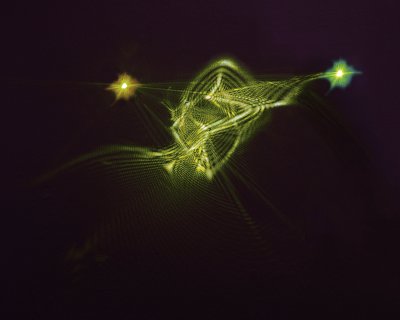Danish physicists have managed to light-up a cloud of atoms using light teleported from a source half a metre away.

Since Charles Bennett and his team first proposed quantum teleportation in 1993, science fiction enthusiasts have had to be content with frustratingly prosaic examples of the principle. However, at the University of Copenhagen in Denmark, physicists have passed a milestone that will help to bring some practical applications of teleportation within sight (Nature 443 557).
“This is the first time teleportation has been achieved between the ‘flying’ medium of light and the ‘stationary medium’ of atoms,” said Eugene Polzik of Copenhagen. “Such teleportation could serve as a main building block of a quantum network connecting distant quantum processors.”
Quantum teleportation cleverly evades one of the best known peculiarities of quantum states – their inability to be measured precisely. Only some of the information of a quantum state can be learned in a single measurement, and once that measurement is made, the quantum state is effectively destroyed.
To get around this problem, which prevents communication in the classical manner, quantum teleportation makes use of a pair of entangled states. One half of the pair is kept by the sender (affectionately known as “Alice” to quantum physicists), while the other is taken by the receiver (“Bob”) on his travels.
When Alice wants to transmit the quantum state of new particle to Bob, she performs a joint measurement, called a “Bell measurement”, on both it and her half of the entangled pair. She then sends the result over to Bob using any classical means available (telephone, homing pigeon, etc.). Then, by using his half of the entangled pair, he can “reconstruct” an exact copy of the initial state.
In Polzik’s experiment, a beam of light was shone through an ensemble of caesium atoms, possessed by Bob, becoming entangled through a quantum-mechanical version of the Faraday effect, in which the polarization of light rotates as it passes through a medium. The light travelled half a metre to Alice’s location, where it was mixed on a beamsplitter with the object to be teleported – a weak laser pulse. The amplitude and phase of the combined light was then measured on each of the two outputs of the beamsplitter respectively (the Bell measurement), and then sent through a classical channel to Bob.
“The result is that the pure state of the light state is recovered in the atoms,” explained Polzik. “More importantly, our experiment has involved a macroscopic atomic object – something that can, in fact, be visible.”
While the number of atoms in the ensemble may not be quite up to the expectations the science fiction enthusiasts (1012 atoms, as opposed to about 1027 in a small person), the fact that the cloud of caesium is an observable object is a major step towards feasible quantum communication. Large ensembles of atoms could, in the future, serve as “memory nodes” by storing quantum states, using photons for the transmission.
“In free space [teleportation] could be over tens or hundreds of metres,” said Polzik. “We want to do long distance teleportation of a macroscopic object.”



